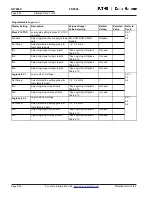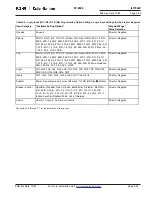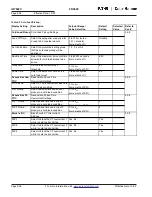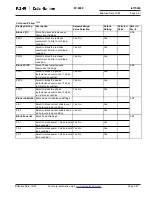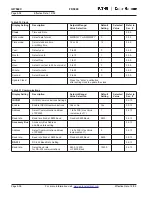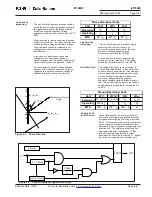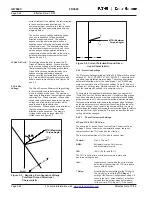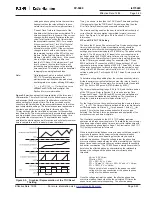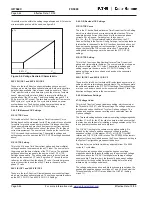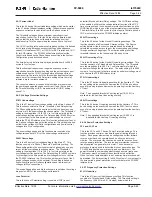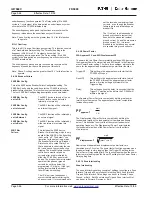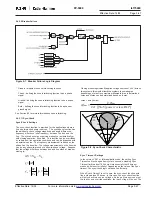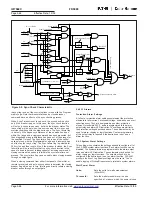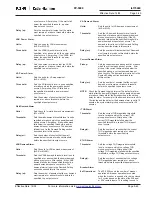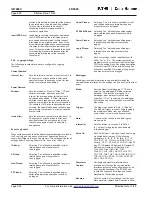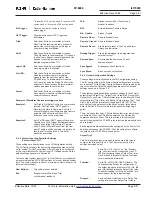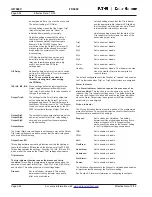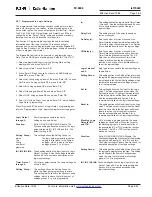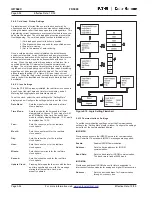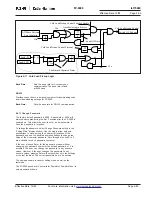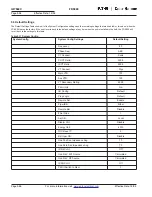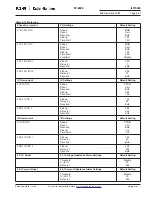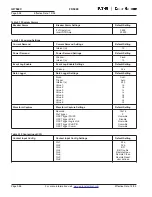
Effective Date: 12/05
For more information visit:
www.eatonelectrical.com
Page 5-43
FP-5000
IL17569C
Page 5-43
Effective Date: 12/05
value goes above pickup before the reset time
has expired then the relay will begin to accu-
mulate time from its last value (percent travel).
“Percent Travel” refers to the percent of the
time delay that the timer has accumulated. The
time overcurrent time is dynamic. If the current
changes it will change its trip times to the new
value. Total trip time will be the time at which
the accumulator reaches 100%. For example,
if the current is at level 1 for 40% of the total
trip time based on level 1 current then the
accumulator will be at 40%. If the current now
changes to level 2 with a new trip time, then
the remaining trip time will be 60% of the new
trip time. So the total trip time will be 40% of
trip time t
1
plus 60% of trip time t
2
. If the current
was to drop below pickup for a time less
than the TOC Reset T in between level 1 and
level 2 currents, then the total trip time will
include the time below pickup to the total trip
time calculated. This feature could be beneficial
to tripping for an arcing fault condition.
Calc:
Calculated reset, which is defined by ANSI
C37.112. This setting represents the
electromechanical induction disk model and
best integrates in a system utilizing E/M relays.
T
reset
= (t
r
x D) / [(I/I
pu
)
2
– 1] where t
r
is a curve
constant and D is the time multiplier. See
Section 8 for more information.
Figure 5.5
provides a graphical representation of the three reset
characteristics. The rms current value is the bottom square wave
and assumes that the current level is either above or below the
pickup setting for a period of time. The three curves above the
current are the time values for the accumulator based on the three
reset characteristic settings. The Instantaneous reset appears as a
saw tooth and will not reach a trip time for this example. The
T Delay setting holds the time fixed at last value for the specified
reset time delay. This model will eventually accumulate enough time
and trip provided the current is not below the pickup setting for a
time greater than the reset time. The calculated reset option
emulates the electromechanical disc action and will slowly reset over
time to complete reset. This model will also trip in time.
Time t
1
, as shown, is less than the TOC Reset T time delay setting.
If t
1
was greater than the TOC Reset T time delay setting, then the
51/w Time Delay Reset curve above would reset to zero.
The direction setting enables the user to select the direction(s) of
current flow for which operation is permitted,
forward
,
reverse
or
both
. See Figure 5.1 and Figure 5.2 in Section 5.4.1 for more
information.
51P and 51P-2 PH TOC Setting
These are the 51 device Phase Inverse Time Overcurrent pickup and
time multiplier settings. A proper coordination study should be
completed to determine the overcurrent pickup and time delay
settings prior to commissioning the FP-5000 relay. The pickup setting
(range: 0.1 to 4.0 per unit in 0.01 steps) is the overcurrent value in
per unit at which the FP-5000 starts to time out to trip. To reference
this setting to the Primary System Current simply multiply this setting
by the CT primary connected rating. For example, if the CT is an
800/5 multi ratio CT connected at 600/5, then a setting of 0.7 will
represent a primary current pickup of 420 A (0.7 times 600). In terms
of the relay current used for bench testing, use the nominal current
rating of the FP-5000 model, which is either 5 A or 1 A. So for a 5 A
version a setting of 0.7 will require 3.5 A (0.7 times 5) relay current to
operate.
To determine the pickup setting from the coordination study, simply
divide the primary current value that you want the relay to trip at by
the primary CT rating. For example, if you want the relay to operate
at 570 A; set it to 0.95 per unit (570 A divided by 600 A).
The time multiplier setting (range: 0.05 to 10.0) sets the time portion
of the TOC curve. Refer to Section 13 to view the Inverse Time
Overcurrent Curves. The ANSI and IEC curves and multipliers are
per their respective standards and definitions. The current scale
along the x-axis is in terms of multiples of pickup (I/I
pu
).
For the thermal curves, the current scale along the x-axis is in terms
of I
nom
(or CT). The time multiplier is defined as the relay trip time at a
current value equal to 3 times (I
nom
) for phase and 1 times (I
nom
) for
ground. The relay trip times are dependent on the curve type
selected. See Section 8 for curve equations and application of the
protective curves and time multipliers.
The Vrestraint, available on the 51P-2 TOC setting, restrains
operation which reduces pickup levels. This allows the user to lower
the pickup value of each phase time overcurrent in relationship with
the corresponding phase input voltage. The Vrestraint on the 51P-1
TOC setting is reserved for future use.
When the minimum fault phase current is close to the load current, it
may make the phase time overcurrent protection coordination
difficult. In this case an undervoltage function may be used to
alleviate this situation. When the voltage is low, the phase time
overcurrent pickup threshold may be set low accordingly, so that the
phase time overcurrent protection may achieve adequate sensitivity
and better coordination. The FP-5000 uses a simple linear model to
determine the effective pickup by characterizing the relationship
between the voltage and the phase time overcurrent pickup
threshold.
Vmin = 0.25*Vmax;
P%min = 25%;
P% = 25%, if V <= Vmin;
P% = 1/Vmax*(V - Vmin) + 25%, if Vmin < V < Vmax;
P% = 100%, if V >= Vmax;
Where Vmax is less or equal to the phase to neutral
voltage for the wye connection or the phase to phase
voltage for the delta connection.
Once the voltage restraint is enabled, the effective phase time
overcurrent pickup threshold will be the calculated P% times the
phase time overcurrent pickup setting. The effective pickup
Figure 5-5.
Graphical Representation of the TOC Reset
T Setting






